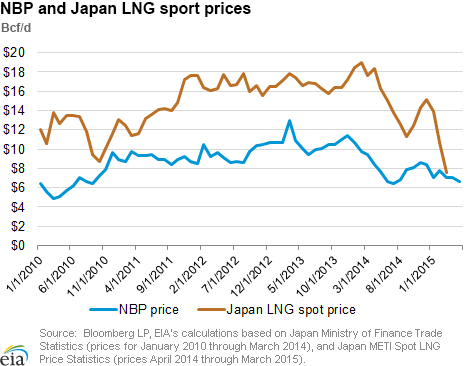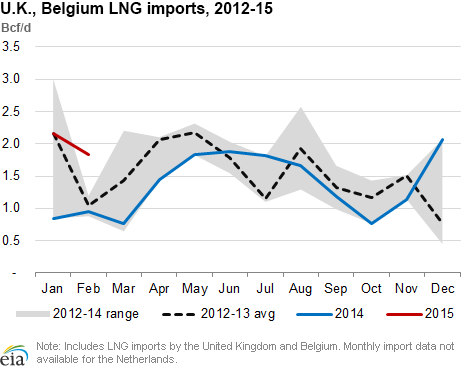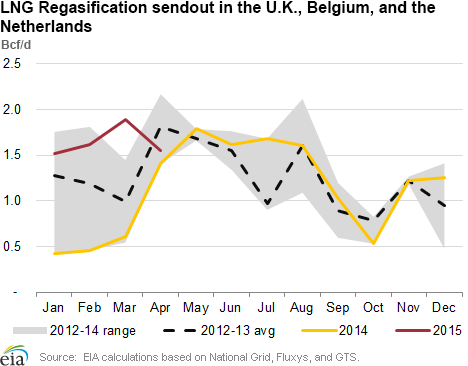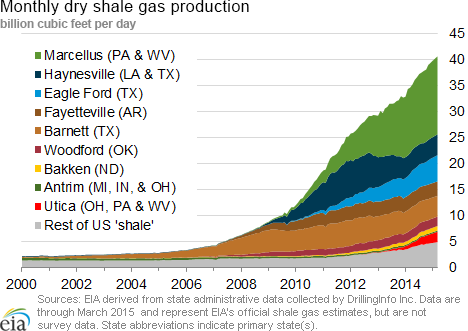In the News:
Northwest Europe doubles LNG imports as key prices converge
Liquefied natural gas (LNG) shipped to northwestern Europe's regasification terminals in the United Kingdom (U.K.), Belgium, and the Netherlands more than doubled in the first quarter of 2015, compared with the same period in 2014, as reduced demand and decreasing spot prices in Asian markets made more LNG available to spot markets in the Atlantic Basin. LNG shipments to the U.K. and Belgium averaged 2.0 Bcf/d in January and February 2015, a 122% increase over the same period last year, when LNG shipments averaged 0.9 Bcf/d.
In Asian markets, mild weather, high LNG stocks, and weak demand for natural gas in the power sector contributed to lower demand for spot LNG cargos in the region for the first three months of 2015. In the three largest Asian markets—Japan, South Korea, and China—LNG imports declined by 6% (1.3 Bcf/d) in the first quarter of 2015 compared with the first quarter of 2014. South Korea experienced the largest decline (1.36 Bcf/d) year-on-year in the first quarter of 2015 when high storage inventories and weak power sector demand reduced the need for spot LNG. Chinese LNG imports decreased 0.25 Bcf/d in the first three months of 2015 from a year earlier. In contrast, Japan increased its LNG imports by 0.31 Bcf/d.
While northwest European imports of LNG doubled in the first quarter of 2015 compared with the same period in 2014, sendout from regasification terminals increased even more. Total LNG regasification sendout in northwest Europe averaged 1.7 Bcf/d in the first three months of 2015, significantly higher than the average sendout of 0.5 Bcf/d in the same period last year, according to data by National Grid, Fluxys, and GTS. Last year’s winter in Europe was one of the warmest on record, with low natural gas demand and high storage stocks. However, even with the increased sendout this year, it was considerably lower than the 7.1 Bcf/d combined regasification capacity of the three countries, implying a 24% utilization rate.
Despite a colder winter in 2014-15 and relatively low storage levels at the end of the heating season, both in the U.K. and the Continent, spot prices at the U.K.’s benchmark National Balancing Point (NBP) remained low in the first quarter of 2015, averaging $7.28 per million Btu (MMBtu), 27% lower than in the same period of last year, and their lowest level since 2010. While the NBP price briefly spiked in February to $7.75/MMBtu, following the announcement of a continued cap on production from the Groningen field in the Netherlands, it declined again in March and remained around $7/MMBtu in April. The price decline was driven in part by gas-on-gas competition with the pipeline imports to Continental Europe, where prices for pipeline gas with contractual linkages to oil have been decreasing, given the decline in oil prices.
With spot LNG prices in Asian markets declining below NBP prices, it was more advantageous for sellers to send spot cargos to northwest Europe, as transportation differentials for Middle Eastern and Atlantic Basin supplies favor European markets over Asian markets. Japan spot prices in March, at $7.60/MMBtu, were the lowest since the summer of 2009, and converged with NBP prices for the first time since 2010. This is primarily a result of lower Asian demand, additional Pacific Basin LNG supply, and, with declining crude oil prices, decreasing oil-linked contract LNG prices, the pricing mechanism for most Japanese LNG imports.
Overview:
(For the Week Ending Wednesday, April 29, 2015)
- The prices at most trading locations increased through the report week (Wednesday, April 29-Wednesday, May 6). Henry Hub spot prices started the week at $2.56/MMBtu last Wednesday, and rose 19¢ to $2.75/MMBtu yesterday.
- At the New York Mercantile Exchange (Nymex), the June prompt month contract opened the report week last Wednesday at $2.606/MMBtu, increased during the week and ended up at $2.776/MMBtu yesterday.
- Working natural gas in storage increased to 1,786 Bcf as of Friday, May 1, according to the U.S. Energy Information Administration (EIA) Weekly Natural Gas Storage Report (WNGSR). A net injection into storage of 76 Bcf for the week resulted in storage levels 71.1% above year-ago levels and 3.6% below the five-year average for this week.
- The total rig count for May 1 fell by 27 units to 905 rigs, according to data reported by Baker Hughes Inc. Oil rigs fell by 24 units to 679 and gas rigs fell by 3 to 222. The largest reduction was 8 rigs overall in the Permian Basin, followed by Eagle Ford dropping 7 oil rigs, but gaining 2 for natural gas.
- The natural gas plant liquids composite price, for the week ending May 1, was unchanged from the previous week at $5.70/MMBtu. With the exception of natural gasoline, which fell by 0.8%, all of the other Mont Belvieu natural gas liquids spot prices rose slightly this week. The price of ethane increased by 0.1%, propane increased by 0.3%, butane increased by 0.9%, and isobutane increased by 0.2%.
Prices/Demand/Supply:
Maintenance and warming weather lift prices. With planned and unplanned maintenance, along with higher-than-average temperatures, most trading locations experienced increasing prices through the week. Henry Hub spot prices started the report week at $2.56/MMBtu last Wednesday and moved up through the week, closing yesterday at $2.75/MMBtu. At Chicago Citygate, where temperatures began the week on the cool side, prices started the report week at $2.57/MMBtu and gained 17¢ to close at $2.74/MMBtu.
Prices in the Northeast are mixed. The Northeast, especially New England, bucked the rising trend through the report week. Prices at the Algonquin Citygate, which serves Boston, started the week at $2.52/MMBtu last Wednesday and fell to $1.66/MMBtu on Friday before rising to $2.06/MMBtu yesterday, closing 69¢ below the Henry Hub price. This was an overall decrease of about 20% for the week. Similarly, prices at Tennessee Zone 6 200L, with deliveries into New England, opened Wednesday, April 29, at $2.52/MMBtu, fell to $1.75/MMBtu on Friday, and recovered some to close at $2.23/MMBtu yesterday.
At Transcontinental Zone 6 New York, serving New York City, prices began the report week at $2.44/MMBtu, then rose 36¢ over the week, closing at $2.80/MMBtu yesterday, just above the Henry Hub price. On May 1, Transcontinental Pipeline began work on the Leidy Southeast Expansion, a scheduled 43-day maintenance that will loop, or double, a segment of its pipeline between Station 505 and Princeton Junction in New Jersey (Station 210 Pool). Bentek Energy estimated that this maintenance could reduce flows through Leidy by 0.8 billion cubic feet per day (Bcf/d) or more, potentially constraining Northeast production and reducing supplies to New York and the Northeast.
Marcellus prices remain low. At Tennessee's Zone 4 Marcellus trading location, prices opened the week at $1.35/MMBtu last Wednesday, fell below $1 to $0.96/MMBtu on Friday, rose to $1.45/MMBtu in trading on Tuesday, and closed the week at $1.31/MMBtu yesterday. On the Transco Leidy Line, prices began the report week at $1.42/MMBtu last Wednesday, dropped to the week's low of $1.11/MMBtu on Friday, and gained to close at $1.49/MMBtu yesterday. At the Dominion South trading point, prices began the report week at $1.45/MMBtu, fluctuated a little through Friday, but rose to close the week at $1.73/MMBtu yesterday.
Nymex prices up for the week. June's near-month spot contract opened at $2.606/MMBtu last Wednesday and closed the report week at $2.776/MMBtu, up 17¢. The 12-month strip, representing the average of contracts from June 2015 through May 2016, rose over the report week by 14¢, starting last Wednesday at $2.885/MMBtu and closing yesterday at $3.029/MMBtu.
Total supply decreases slightly. According to data from Bentek Energy, total supply decreased by 1.2% week over week as a result of reduced production and lower imports. Dry natural gas production decreased by 0.8%, though it remained 8% greater than the same week last year. Some of the decrease in production may be attributed to the maintenance on Transco's Leidy Line, noted previously, as well as a force majeure declared by Destin Pipelines because of problems at its MP260 offshore platform in the Gulf of Mexico. Imports of Canadian natural gas into the United States dropped off this week, falling 6.4%. Midwestern imports from Canada, which increased by 16.5%, were offset by a reduction of Northeast gas imports, which dropped significantly, likely in response to temperatures that were more than 10° above those of the previous week. LNG sendout was down, with volumes remaining minimal.
Consumption decreases with higher temperatures. Total natural gas consumption fell by 10.8% week over week, with decreased consumption in industrial and residential/commercial sectors, and an increase in both the power sector and exports to Mexico. With many areas experiencing warming temperatures, some above normal, residential/commercial demand fell by more than 30%. Industrial consumption fell as well, dropping 3.4%. Natural gas consumption for electric generation (power burn) increased 0.6% for the week, up by 13.9% over the same period in 2014. Power burn trends were mixed regionally, with the Northeast, Texas, Southwest and the Rockies increasing, up 15.3%, 5.9%, 7.0% and 5.1%, respectively last week. Regionally, the largest increase in power burn was in the Northeast, where it was up 25.7% over the same period last year. Exports to Mexico were up 1.7% this week, which is 25.6% higher than the same week last year.
Storage
Net storage injection is larger than both five-year average and last year's builds. The net injection reported for the week ending May 1 was 76 Bcf, down from 81 Bcf the previous week. This compares with the five-year average net increase of 68 Bcf for that week and last year's net increase of 75 Bcf. Working gas inventories for the storage week totaled 1,786 Bcf, 742 Bcf (71.1%) higher than last year at this time and 67 Bcf (3.6%) lower than the five–year (2010–14) average.
Storage injections are larger than market expectations. Market expectations, on average, called for a build of 75 Bcf. When the EIA storage report was released at 10:30 a.m. on May 7, the price for the June natural gas futures contract decreased 5¢ to $2.74/MMBtu in trading on the Nymex, but rose to $2.77 a few minutes later.
From the week ending on April 3 (the beginning of the injection season) through the week ending on May 1, net storage injections have totaled 325 Bcf, or 54% more than the 211 Bcf injected during the same five weeks in 2014. There was 202 Bcf injected during these weeks between 2010 and 2014, on average. The estimated average unit value of what storage holders put into storage from April 3 to May 1 this year was $2.61/MMBtu, 44% lower than the average value for the same 5 weeks last year of $4.70/MMBtu. The highest winter-month Nymex price (for the January 2016 contract) in trading for the week ending on May 1 averaged $3.15/MMBtu. This is 55¢ more than the June Nymex contract price. A year ago, the difference was 18¢/MMBtu, suggesting there is more financial incentive this year to buy and store gas in the summer for sale in the winter.
There are currently 26 more weeks in the injection season, which traditionally runs from April 1 through October 31, although in many years injections continue into November. EIA forecasts that the end-of-October working natural gas inventory level will be 3,781 Bcf, which, as of May 1, would require an average injection of 77 Bcf per week through the end of October. EIA's forecast for the end-of-October inventory level is below the five-year (2010–14) average peak storage value of 3,813 Bcf. To reach the five-year average peak value, average weekly injections through the end of October would need to be 78 Bcf.
All three regions report net injections for the week. The East, West, and Producing regions had net injections of 31 Bcf (5 Bcf smaller than its five-year average injection), 7 Bcf (2 Bcf smaller than its five-year average), and 38 Bcf (16 Bcf larger than its five-year average), respectively. The East region's inventory is below its five-year average by 161 Bcf (20.4%). In contrast, stock levels in the West and Producing regions are above their five-year averages for the week, by 71 Bcf (23.9%) and 23 Bcf (3.0%), respectively. Storage levels for the East, West, and Producing regions are above their year-ago levels by 236 Bcf, 167 Bcf, and 339 Bcf, respectively.
Temperatures during the storage report week cooler than normal. Temperatures in the Lower 48 states averaged 55° Fahrenheit for the storage report week, 1.9° cooler than the 30-year normal temperature and 1.3° cooler than the average temperature during the same week last year. There were 81 population-weighted heating degree days (HDD) during the storage report week, 22 HDD higher than the five-year average and 7 HDD higher than during the same period last year. There were also 11 population-weighted cooling degree days during the same report week.
See also:
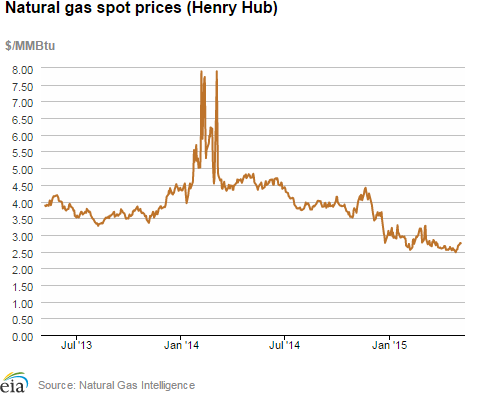
| Spot Prices ($/MMBtu) | Thu, 30-Apr |
Fri, 01-May |
Mon, 04-May |
Tue, 05-May |
Wed, 06-May |
|---|---|---|---|---|---|
| Henry Hub |
2.57 |
2.67 |
2.72 |
2.76 |
2.75 |
| New York |
2.61 |
2.65 |
2.76 |
2.81 |
2.80 |
| Chicago |
2.57 |
2.67 |
2.70 |
2.74 |
2.74 |
| Cal. Comp. Avg,* |
2.63 |
2.72 |
2.80 |
2.79 |
2.78 |
| Futures ($/MMBtu) | |||||
| June contract |
2.751 |
2.776 |
2.821 |
2.780 |
2.776 |
| July contract |
2.802 |
2.831 |
2.878 |
2.836 |
2.828 |
| *Avg. of NGI's reported prices for: Malin, PG&E citygate, and Southern California Border Avg. | |||||
| Source: NGI's Daily Gas Price Index | |||||
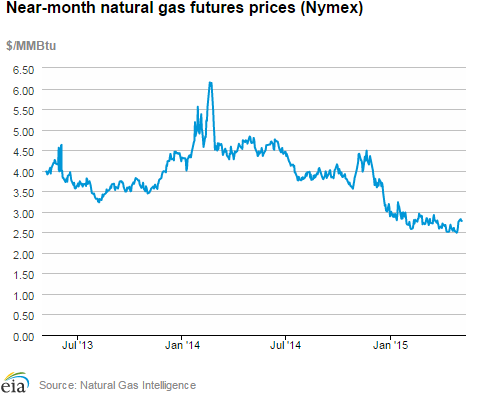
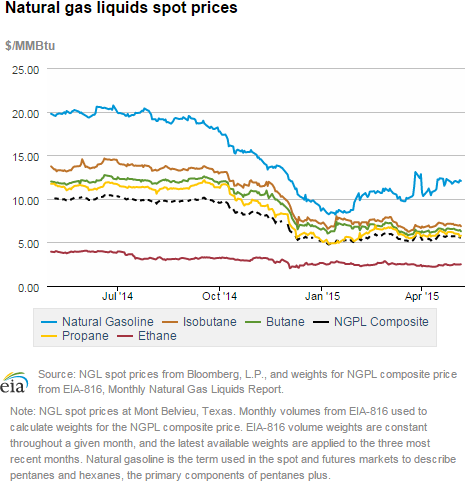
| U.S. natural gas supply - Gas Week: (4/29/15 - 5/6/15) | ||
|---|---|---|
Percent change for week compared with: |
||
last year |
last week |
|
| Gross production | 8.03%
|
-0.80%
|
| Dry production | 7.96%
|
-0.79%
|
| Canadian imports | -5.32%
|
-6.42%
|
| West (net) | 12.90%
|
-4.70%
|
| Midwest (net) | -13.52%
|
16.50%
|
| Northeast (net) | -10572.22%
|
-225.75%
|
| LNG imports | -70.28%
|
-19.49%
|
| Total supply | 6.92%
|
-1.17%
|
| Source: BENTEK Energy LLC | ||
| U.S. consumption - Gas Week: (4/29/15 - 5/6/15) | ||
|---|---|---|
Percent change for week compared with: |
||
last year |
last week |
|
| U.S. consumption | -0.1%
|
-11.3%
|
| Power | 13.9%
|
0.6%
|
| Industrial | -2.1%
|
-3.4%
|
| Residential/commercial | -13.8%
|
-30.9%
|
| Total demand | 0.7%
|
-10.8%
|
| Source: BENTEK Energy LLC | ||
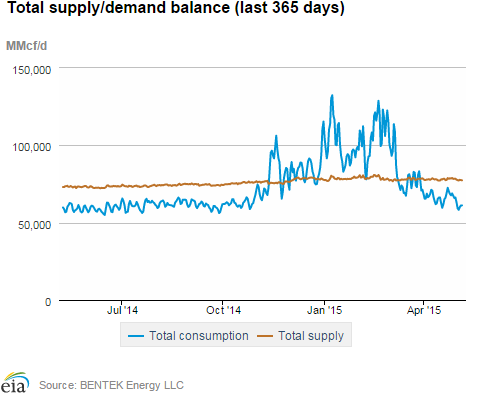
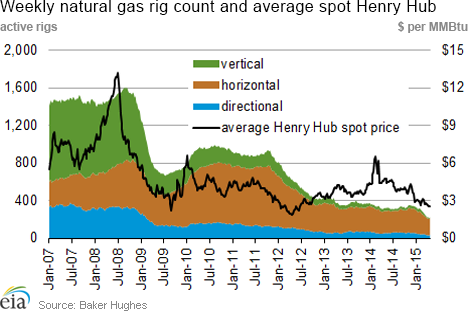
| Rigs | |||
|---|---|---|---|
Fri, May 01, 2015 |
Change from |
||
last week |
last year |
||
| Oil rigs | 679 |
-3.41% |
-55.53% |
| Natural gas rigs | 222 |
-1.33% |
-31.27% |
| Miscellaneous | 4 |
0.00% |
0.00% |
| Rig numbers by type | |||
|---|---|---|---|
Fri, May 01, 2015 |
Change from |
||
last week |
last year |
||
| Vertical | 113 |
-6.61% |
-71.46% |
| Horizontal | 699 |
-2.92% |
-43.95% |
| Directional | 93 |
2.20% |
-55.92% |
| Source: Baker Hughes Inc. | |||
| Working gas in underground storage | ||||
|---|---|---|---|---|
Stocks billion cubic feet (bcf) |
||||
| Region | 2015-05-01 |
2015-04-24 |
change |
|
| East | 628 |
597 |
31 |
|
| West | 368 |
361 |
7 |
|
| Producing | 790 |
752 |
38 |
|
| Total | 1,786 |
1,710 |
76 |
|
| Source: U.S. Energy Information Administration | ||||
| Working gas in underground storage | |||||
|---|---|---|---|---|---|
Historical comparisons |
|||||
Year ago (5/1/14) |
5-year average (2010-2014) |
||||
| Region | Stocks (Bcf) |
% change |
Stocks (Bcf) |
% change |
|
| East | 392 |
60.2 |
789 |
-20.4 |
|
| West | 201 |
83.1 |
297 |
23.9 |
|
| Producing | 451 |
75.2 |
767 |
3.0 |
|
| Total | 1,044 |
71.1 |
1,853 |
-3.6 |
|
| Source: U.S. Energy Information Administration | |||||
| Temperature -- heating & cooling degree days (week ending Apr 30) | ||||||||
|---|---|---|---|---|---|---|---|---|
HDD deviation from: |
CDD deviation from: |
|||||||
| Region | HDD Current |
normal |
last year |
CDD Current |
normal |
last year |
||
| New England | 120
|
16
|
-9
|
0
|
0
|
0
|
||
| Middle Atlantic | 107
|
20
|
-2
|
0
|
0
|
0
|
||
| E N Central | 128
|
36
|
35
|
0
|
-1
|
0
|
||
| W N Central | 89
|
8
|
-13
|
0
|
-3
|
-1
|
||
| South Atlantic | 63
|
24
|
23
|
29
|
7
|
-5
|
||
| E S Central | 54
|
19
|
33
|
5
|
-4
|
-9
|
||
| W S Central | 19
|
7
|
6
|
33
|
2
|
-13
|
||
| Mountain | 87
|
-5
|
-12
|
7
|
-5
|
1
|
||
| Pacific | 36
|
-18
|
-15
|
8
|
3
|
3
|
||
| United States | 81
|
13
|
7
|
11
|
0
|
-2
|
||
|
Note: HDD = heating degree-day; CDD = cooling degree-day Source: National Oceanic and Atmospheric Administration | ||||||||
Average temperature (°F)
7-Day Mean ending Apr 30, 2015
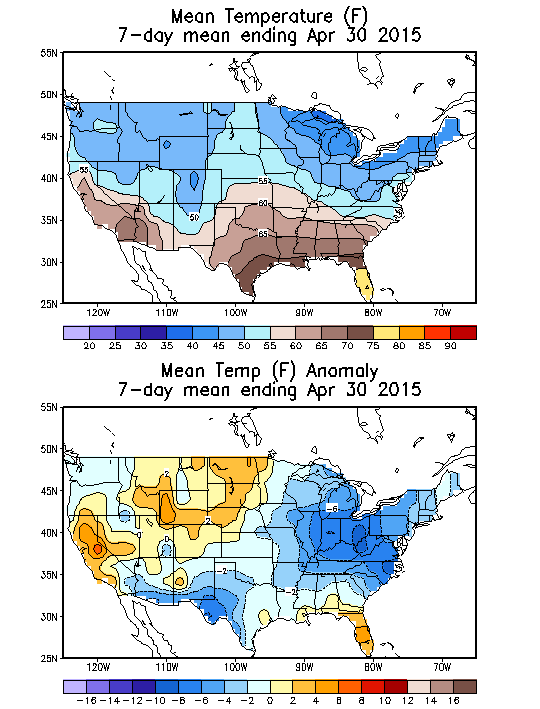
Source: NOAA/National Weather Service
Deviation between average and normal (°F)
7-Day Mean ending Apr 30, 2015

Source: NOAA/National Weather Service

